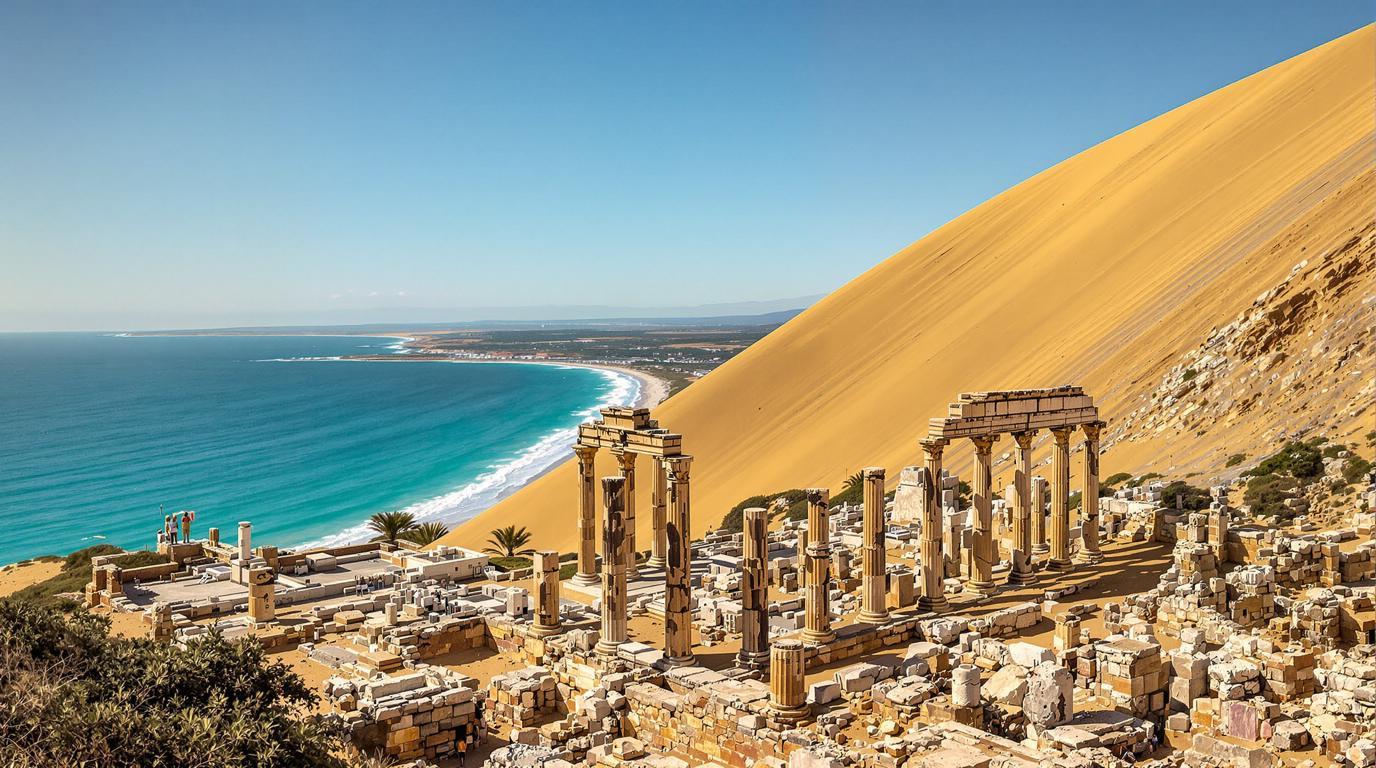The wind whispered secrets through the dunes as I crested the final sandy hill, revealing a sight that stopped me in my tracks. Below, a perfect crescent of untouched golden sand curved alongside turquoise waters, while ancient stone columns rose from the earth like forgotten sentinels. Playa de Bolonia had remained Spain’s best-kept secret, a rare collision of pristine nature and ancient history that few travelers ever discover.
Where Roman ruins meet Europe’s most spectacular dunes
Nestled in Andalusia’s southernmost reaches, just 12 miles from Morocco’s distant shoreline, Bolonia exists in splendid isolation. The beach itself stretches nearly 2.5 miles, backed by a towering 100-foot sand dune that shifts and reshapes with each passing storm. But what truly sets Bolonia apart is the juxtaposition of this natural wonder with Baelo Claudia, a remarkably preserved 2nd century Roman city whose ruins cascade almost to the water’s edge.
“Most visitors rush to Spain’s Mediterranean resorts,” explained Manuel, a local guide whose family has lived here for generations. “Here, time moves differently. The Atlantic winds that carved our dune have been blowing since Caesar’s legionaries walked these streets.”
Three hidden corners that most travelers never find
The secret tide pools of Punta Camarinal
A half-hour walk west from Bolonia’s main beach, I discovered a landscape that could have been lifted from another planet. Massive flat rock formations create natural infinity pools where warm seawater collects during low tide. As families crowded Bolonia’s central stretch, I had this otherworldly place entirely to myself, sharing it only with tiny crabs scuttling between miniature canyons carved by millennia of waves.
This secluded spot rivals the more famous pools found on hidden Greek islands with ancient churches but remains refreshingly undeveloped, with no facilities or signposts to guide casual tourists.
The forgotten watchman’s path
Beyond the ruins, a barely visible trail winds up the pine-covered hillside toward Torre de la Peña, an 18th-century watchtower built to spot Barbary pirates. The 40-minute climb rewards hikers with panoramic views that stretch across two continents, with Africa’s misty mountains visible on clear days. Unlike the increasingly popular medieval villages of Europe such as France’s fortress villages frozen in time, this lonely sentinel stands exactly as it has for centuries.
Flavors from the edge of Europe
Forget paella and sangria – Bolonia’s cuisine speaks to its position at the continental frontier. At El Cabrito, a tiny family-run eatery overlooking the dunes, I discovered atún encebollado – local bluefin tuna slow-simmered with sweet onions and sherry vinegar. The dish represents centuries of cultural exchange across the Strait of Gibraltar, with North African spices complementing the Atlantic’s bounty.
For the true local experience, visit during May’s tuna migration, when fishermen still practice the ancient almadraba technique, a sustainable tuna-catching method dating back to Phoenician times.
Essential wisdom for the Bolonia traveler
When to embrace the wind
Levante winds blow fiercely between June and September, creating perfect conditions for kitesurfing but potentially challenging days for sunbathers. May and October offer the ideal balance of warm temperatures and calmer conditions, with fewer visitors competing for space.
Like the microclimate that allows palm trees to flourish on this unique French island near Brittany, Bolonia’s position creates unpredictable weather patterns. Check wind forecasts before committing to your visit.
Transportation truths
Public buses run infrequently (twice daily in summer, rarely in winter) from Tarifa, the nearest town. Renting a car is practically essential, with parking available at the beach’s eastern entrance. Arrive before 11am during summer months to secure a spot before day-trippers arrive from nearby resorts.
The enduring magic of borderlands
As sunset painted the ancient columns golden and the dune turned rose-pink, I understood Bolonia’s profound appeal. In our hyper-connected world, true frontiers have almost vanished. Yet here, where continents meet and empires once ended, that elusive sense of standing at the edge of something vast and unknowable still remains – a rare gift for those willing to venture beyond the familiar.
